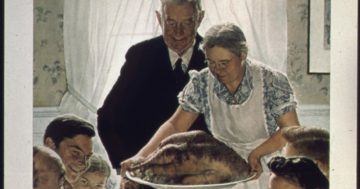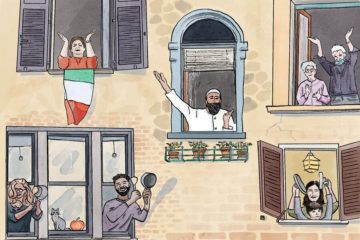Sander van der Linden in Scientific American:
 For centuries people have pondered the meaning of dreams. Early civilizations thought of dreams as a medium between our earthly world and that of the gods. In fact, the Greeks and Romans were convinced that dreams had certain prophetic powers. While there has always been a great interest in the interpretation of human dreams, it wasn’t until the end of the nineteenth century that Sigmund Freud and Carl Jung put forth some of the most widely-known modern theories of dreaming. Freud’s theory centred around the notion of repressed longing — the idea that dreaming allows us to sort through unresolved, repressed wishes. Carl Jung (who studied under Freud) also believed that dreams had psychological importance, but proposed different theories about their meaning.
For centuries people have pondered the meaning of dreams. Early civilizations thought of dreams as a medium between our earthly world and that of the gods. In fact, the Greeks and Romans were convinced that dreams had certain prophetic powers. While there has always been a great interest in the interpretation of human dreams, it wasn’t until the end of the nineteenth century that Sigmund Freud and Carl Jung put forth some of the most widely-known modern theories of dreaming. Freud’s theory centred around the notion of repressed longing — the idea that dreaming allows us to sort through unresolved, repressed wishes. Carl Jung (who studied under Freud) also believed that dreams had psychological importance, but proposed different theories about their meaning.
Since then, technological advancements have allowed for the development of other theories. One prominent neurobiological theory of dreaming is the “activation-synthesis hypothesis,” which states that dreams don’t actually mean anything: they are merely electrical brain impulses that pull random thoughts and imagery from our memories. Humans, the theory goes, construct dream stories after they wake up, in a natural attempt to make sense of it all. Yet, given the vast documentation of realistic aspects to human dreaming as well as indirect experimental evidence that other mammals such as cats also dream, evolutionary psychologists have theorized that dreaming really does serve a purpose. In particular, the “threat simulation theory” suggests that dreaming should be seen as an ancient biological defence mechanism that provided an evolutionary advantage because of its capacity to repeatedly simulate potential threatening events – enhancing the neuro-cognitive mechanisms required for efficient threat perception and avoidance.
So, over the years, numerous theories have been put forth in an attempt to illuminate the mystery behind human dreams, but, until recently, strong tangible evidence has remained largely elusive.
More here.

 You might recall the strange case of Matthew J. Mayhew, professor of educational administration at The Ohio State University. In late September he published
You might recall the strange case of Matthew J. Mayhew, professor of educational administration at The Ohio State University. In late September he published  At the heart of Oxford’s effort to produce a Covid vaccine are half a dozen scientists who between them brought decades of experience to the challenge of designing, developing, manufacturing and trialling a
At the heart of Oxford’s effort to produce a Covid vaccine are half a dozen scientists who between them brought decades of experience to the challenge of designing, developing, manufacturing and trialling a  “AND WHAT ABOUT unbiased research? What about pure knowledge?” bursts out the more idealistic of the two debaters. Before the other, the more cynical one, even has a chance to answer, the idealist ambushes him with even grander questions: “What about the truth, my dear sir, which is so intimately bound up with freedom, and its martyrs?” We can picture the caustic smile on the cynic’s face. “My good friend,” the cynic answers, “there is no such thing as pure knowledge.” His words come out calmly, fully formed, in sharp contrast to the idealist’s passionate, if sometimes logically disjointed pronouncements. The cynic’s rebuttal is merciless:
“AND WHAT ABOUT unbiased research? What about pure knowledge?” bursts out the more idealistic of the two debaters. Before the other, the more cynical one, even has a chance to answer, the idealist ambushes him with even grander questions: “What about the truth, my dear sir, which is so intimately bound up with freedom, and its martyrs?” We can picture the caustic smile on the cynic’s face. “My good friend,” the cynic answers, “there is no such thing as pure knowledge.” His words come out calmly, fully formed, in sharp contrast to the idealist’s passionate, if sometimes logically disjointed pronouncements. The cynic’s rebuttal is merciless: Our quest centres on this simple question: why do so many languages and cultures identify these North American natives as “the birds from India” (oiseaux d’Inde, or simply dinde in French).
Our quest centres on this simple question: why do so many languages and cultures identify these North American natives as “the birds from India” (oiseaux d’Inde, or simply dinde in French). Truth is, this year has seen plenty of gratitude, instinctively and generously expressed. The people applauding out their windows for emergency responders, the heart signs, the food deliveries to essential workers, the neighborhood trash teams, the looking-in on elders. Online platforms as purpose-built as gratefulness.org and as customarily combative as Twitter have been flooded with counted blessings: for our loved ones, for the Amazon carrier, for our dogs. People gave thanks for simple things, mostly – their families, video chats, the “tall green trees that are older than me,” a hummingbird, the ocean, soup. (“Yep, soup,” says a West Sacramento, California, man.) But many, many other expressions of gratitude took the form of generosity, of trying to give back or pay it forward. The news was filled with stories of people in grocery lines paying for the customer coming next, donations to farmworkers, businesses furnishing free meals to front-line responders.
Truth is, this year has seen plenty of gratitude, instinctively and generously expressed. The people applauding out their windows for emergency responders, the heart signs, the food deliveries to essential workers, the neighborhood trash teams, the looking-in on elders. Online platforms as purpose-built as gratefulness.org and as customarily combative as Twitter have been flooded with counted blessings: for our loved ones, for the Amazon carrier, for our dogs. People gave thanks for simple things, mostly – their families, video chats, the “tall green trees that are older than me,” a hummingbird, the ocean, soup. (“Yep, soup,” says a West Sacramento, California, man.) But many, many other expressions of gratitude took the form of generosity, of trying to give back or pay it forward. The news was filled with stories of people in grocery lines paying for the customer coming next, donations to farmworkers, businesses furnishing free meals to front-line responders. Mark Ellison stood on the raw plywood floor, staring up into the gutted nineteenth-century town house. Above him, joists, beams, and electrical conduits crisscrossed in the half-light like a demented spider’s web. He still wasn’t sure how to build this thing. According to the architect’s plans, this room was to be the master bath—a cocoon of curving plaster shimmering with pinprick lights. But the ceiling made no sense. One half of it was a barrel vault, like the inside of a Roman basilica; the other half was a groin vault, like the nave of a cathedral. On paper, the rounded curves of one vault flowed smoothly into the elliptical curves of the other. But getting them to do so in three dimensions was a nightmare. “I showed the drawings to the bass player in my band,” Ellison said. “He’s a physicist, so I asked him, ‘Could you do the calculus for this?’ He said, ‘No.’ ”
Mark Ellison stood on the raw plywood floor, staring up into the gutted nineteenth-century town house. Above him, joists, beams, and electrical conduits crisscrossed in the half-light like a demented spider’s web. He still wasn’t sure how to build this thing. According to the architect’s plans, this room was to be the master bath—a cocoon of curving plaster shimmering with pinprick lights. But the ceiling made no sense. One half of it was a barrel vault, like the inside of a Roman basilica; the other half was a groin vault, like the nave of a cathedral. On paper, the rounded curves of one vault flowed smoothly into the elliptical curves of the other. But getting them to do so in three dimensions was a nightmare. “I showed the drawings to the bass player in my band,” Ellison said. “He’s a physicist, so I asked him, ‘Could you do the calculus for this?’ He said, ‘No.’ ” He called the next day. We went out for lunch. We went out for dinner. We went out for drinks. We went out for dinner again. We went out for drinks again. We went out for dinner and drinks again. We went out for dinner and drinks and dinner and drinks and dinner and drinks and dinner and drinks and dinner and drinks and dinner and drinks and dinner and drinks and dinner and drinks and dinner and drinks and dinner and drinks and dinner and drinks and dinner and drinks and dinner and drinks and dinner and drinks and dinner and drinks and dinner and drinks and dinner and drinks and dinner and drinks and dinner and drinks and dinner and drinks and dinner and drinks and dinner and drinks and dinner and drinks and dinner and drinks and dinner and drinks and dinner and drinks and dinner and drinks and dinner and drinks and dinner and drinks and dinner and drinks and dinner and drinks and dinner and drinks and dinner and drinks and dinner and drinks and dinner and drinks and dinner and drinks and dinner and drinks and dinner and drinks and dinner and drinks and dinner and drinks and dinner and drinks and dinner and drinks and dinner and drinks and dinner and drinks and dinner and drinks and dinner and drinks and dinner and drinks and dinner and drinks and dinner and drinks and dinner and drinks and dinner and drinks and dinner and drinks and dinner and drinks and dinner and drinks and dinner and drinks and
He called the next day. We went out for lunch. We went out for dinner. We went out for drinks. We went out for dinner again. We went out for drinks again. We went out for dinner and drinks again. We went out for dinner and drinks and dinner and drinks and dinner and drinks and dinner and drinks and dinner and drinks and dinner and drinks and dinner and drinks and dinner and drinks and dinner and drinks and dinner and drinks and dinner and drinks and dinner and drinks and dinner and drinks and dinner and drinks and dinner and drinks and dinner and drinks and dinner and drinks and dinner and drinks and dinner and drinks and dinner and drinks and dinner and drinks and dinner and drinks and dinner and drinks and dinner and drinks and dinner and drinks and dinner and drinks and dinner and drinks and dinner and drinks and dinner and drinks and dinner and drinks and dinner and drinks and dinner and drinks and dinner and drinks and dinner and drinks and dinner and drinks and dinner and drinks and dinner and drinks and dinner and drinks and dinner and drinks and dinner and drinks and dinner and drinks and dinner and drinks and dinner and drinks and dinner and drinks and dinner and drinks and dinner and drinks and dinner and drinks and dinner and drinks and dinner and drinks and dinner and drinks and dinner and drinks and dinner and drinks and dinner and drinks and dinner and drinks and dinner and drinks and IF THE BOOK
IF THE BOOK Joe Biden’s victory instantly obliterated the Democratic Party’s longstanding charge that Russia was hijacking and compromising US elections. The Biden victory, the Democratic Party leaders and their courtiers in the media now insist, is evidence that the democratic process is strong and untainted, that the system works. The elections ratified the will of the people.
Joe Biden’s victory instantly obliterated the Democratic Party’s longstanding charge that Russia was hijacking and compromising US elections. The Biden victory, the Democratic Party leaders and their courtiers in the media now insist, is evidence that the democratic process is strong and untainted, that the system works. The elections ratified the will of the people. When
When  This month has seen a torrent of news about experimental
This month has seen a torrent of news about experimental  Drugs were doubtless important to Benjamin, who had first smoked hashish in Berlin in 1927. They confirmed his approach to reality and revolution, to art and politics—an approach shaped and sharpened by his experience of Ibiza. He stayed on the island two months, returning for another six in the summer of 1933. Wretchedly sad, he buried himself in his remote past, writing of his Berlin childhood. Yet he also wrote in lascivious detail of his surroundings, that other “remote past,” or so it seemed to him, this “outpost of Europe” apparently untouched by modernity. Here, he could face head-on his central idea that modernity atrophied the capacity to experience the world and tell stories. This is why the Ibizan poet Vicente Valero has titled his as-yet-untranslated book on Benjamin in Ibiza Experiencia y probreza (Experience and Poverty), after the title of a little-known essay Benjamin wrote under the spell of the island. In the hallucinatory splendor of Ibiza, with his future cast to the winds, Benjamin formulated what I would count as his major texts—on the storyteller and on the mimetic faculty—as well as inventing new forms for the essay as a crossover genre that linked dreams, ethnography, thought-figures, and storytelling.
Drugs were doubtless important to Benjamin, who had first smoked hashish in Berlin in 1927. They confirmed his approach to reality and revolution, to art and politics—an approach shaped and sharpened by his experience of Ibiza. He stayed on the island two months, returning for another six in the summer of 1933. Wretchedly sad, he buried himself in his remote past, writing of his Berlin childhood. Yet he also wrote in lascivious detail of his surroundings, that other “remote past,” or so it seemed to him, this “outpost of Europe” apparently untouched by modernity. Here, he could face head-on his central idea that modernity atrophied the capacity to experience the world and tell stories. This is why the Ibizan poet Vicente Valero has titled his as-yet-untranslated book on Benjamin in Ibiza Experiencia y probreza (Experience and Poverty), after the title of a little-known essay Benjamin wrote under the spell of the island. In the hallucinatory splendor of Ibiza, with his future cast to the winds, Benjamin formulated what I would count as his major texts—on the storyteller and on the mimetic faculty—as well as inventing new forms for the essay as a crossover genre that linked dreams, ethnography, thought-figures, and storytelling.